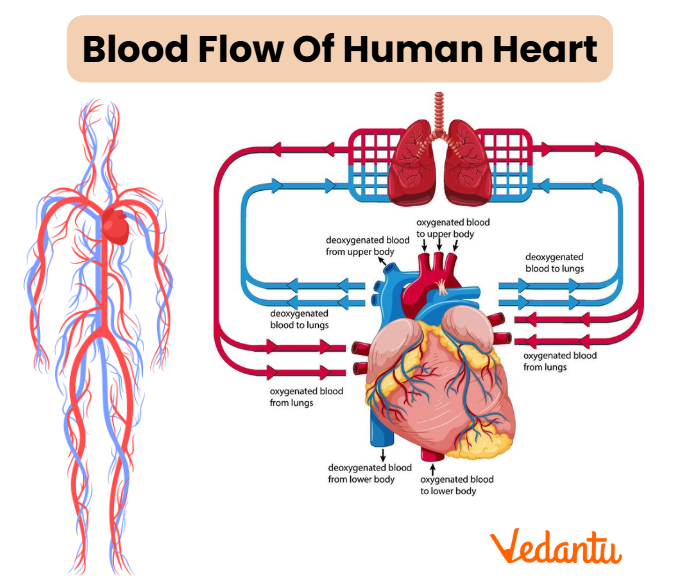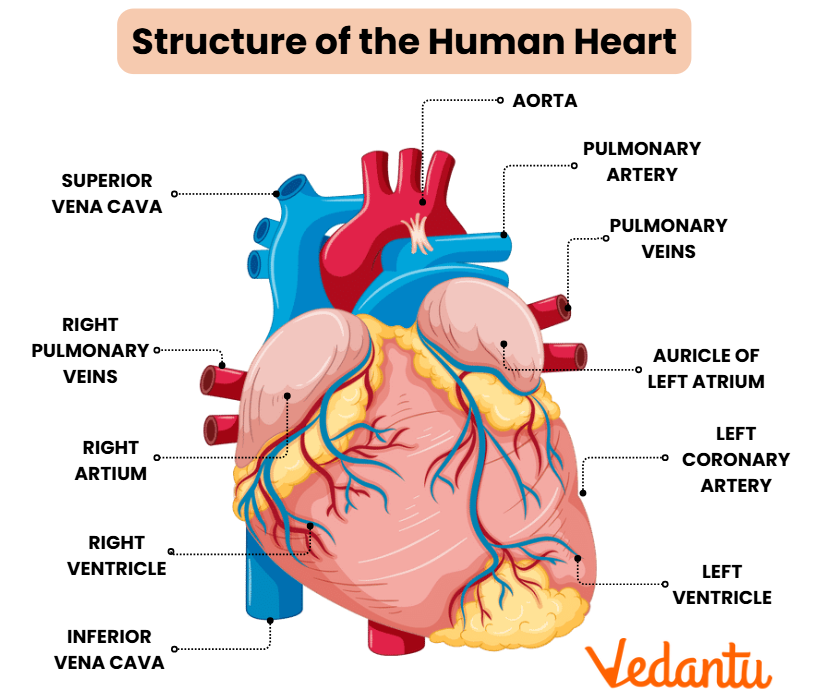Understanding the Human Circulatory System
The human circulatory system is a remarkable network that keeps our body functioning smoothly. In this guide, we explore the circulatory system in the human body—from its organs to its crucial circulatory system function—in a way that’s easy for every student to understand.
Key Components and Functions of the Circulatory System in the Human Body - Overview
The human circulatory system is a closed network that transports essential nutrients, oxygen, hormones, and waste products throughout our body. By pumping blood through a vast network of vessels, this system ensures that every cell receives what it needs to thrive. In this article, we include an easy circulatory system diagram to help visualise these processes.
Read More: Human Body Anatomy

Main Features
Components: The system comprises the heart, blood, blood vessels, and lymph.
Double Circulation: Blood passes through the heart twice in one complete cycle, ensuring efficient separation of oxygenated and deoxygenated blood.
Extensive Network: If the arteries, veins, and capillaries were lined up, they would cover an astonishing distance, demonstrating the vastness of the circulatory system in the human body.
Organ Interconnection: Each organ plays a specific role, contributing to the overall circulatory system function by maintaining a steady supply of nutrients and oxygen.

Organs of the Human Circulatory System
The Heart
The heart is a powerful, muscular organ situated in the chest. Divided into four chambers—two atria (upper chambers) and two ventricles (lower chambers)—it acts as the pump that drives blood throughout the body. In our detailed human circulatory system diagram, the heart is shown at the centre, symbolising its key role.
Blood
Blood is not just a fluid; it is a vital connective tissue responsible for:
Transporting oxygen, nutrients, and hormones.
Removing waste products from cells.
Fighting infections with its white blood cells.
Forming clots via platelets to prevent excessive bleeding.
The components of blood include:
Plasma: The liquid part, which is about 90% water.
Red Blood Cells (RBCs): These cells carry oxygen and nutrients.
White Blood Cells (WBCs): Essential for immune defence.
Platelets: Critical for blood clotting.
Blood Vessels
Blood vessels form the highways for blood flow. They include:
Arteries: These thick, elastic vessels carry oxygenated blood from the heart to different parts of the body. (The exception being the pulmonary arteries, which carry deoxygenated blood to the lungs.)
Veins: Thinner vessels that transport deoxygenated blood back to the heart. (Note that pulmonary and umbilical veins are exceptions as they carry oxygenated blood.)
The Lymphatic System
Often overlooked, the lymphatic system circulates a clear fluid called lymph. This system supports the immune function and helps in the absorption of fats from digested food. Unlike the pumped blood, lymph flows passively through its vessels, aiding in tissue-fluid balance.
Circulatory System Function: Double Circulation

Double circulation is a distinctive feature of the human circulatory system. It involves two separate circuits:
Pulmonary Circulation: Carries deoxygenated blood from the heart to the lungs for oxygenation.
Systemic Circulation: Distributes oxygenated blood from the heart to the rest of the body.
This division ensures that the circulatory system function is highly efficient, keeping our cells supplied with a steady stream of oxygen and nutrients while preventing the mixing of oxygen-rich and oxygen-poor blood.
Visualising the System: Our Easy Circulatory System Diagram
For a clearer understanding, refer to our human circulatory system diagram below. This easy circulatory system diagram is designed for students:
Heart Placement: Centrally located, showing the four chambers.
Vessel Network: Illustrates how arteries, veins, and capillaries spread throughout the body.
Flow Direction: Marks the pathways of oxygenated and deoxygenated blood.
Unique Insights and Additional Learning Points
Historical Evolution
The human circulatory system has evolved significantly over time. Early vertebrates had simpler systems, but the complex double circulation seen today offers a perfect example of nature’s optimisation. Understanding this evolution helps in appreciating how the circulatory system function has been refined to support modern metabolic demands.
Common Health Concerns
Learning about the human circulatory system is not just academic—it also underpins our knowledge of common health issues such as:
Hypertension (High Blood Pressure): Increased pressure can damage arterial walls and lead to complications.
Hypotension (Low Blood Pressure): Insufficient pressure may result in poor circulation.
Stroke: This occurs when blood flow to the brain is interrupted, leading to cell damage.
Aneurysms: Bulges in the artery walls that can rupture if not managed properly.
Interactive Learning with Quiz
Question 1: What is the primary function of the human circulatory system?
A) To digest food
B) To pump blood throughout the body, delivering oxygen and nutrients
C) To produce hormones
D) To control body temperature
Correct Answer: B
Explanation: The main role of the human circulatory system is to pump blood throughout the body, ensuring that oxygen, nutrients, and other vital substances reach every cell, while also removing waste products.
Question 2: What does double circulation in the human body refer to?
A) Blood circulating through the heart twice in one complete cycle
B) The simultaneous circulation of blood and lymph
C) Mixing oxygenated and deoxygenated blood
D) Circulation involving two different heart chambers
Correct Answer: A
Explanation: Double circulation means that blood passes through the heart twice during a single cycle. First, it moves through the pulmonary circuit to get oxygenated in the lungs, and then through the systemic circuit to deliver oxygen throughout the body.
Question 3: Which blood vessel carries oxygenated blood away from the heart?
A) Veins
B) Arteries
C) Capillaries
D) Lymphatic vessels
Correct Answer: B
Explanation: Arteries are responsible for carrying oxygenated blood from the heart to various parts of the body, except for the pulmonary arteries which carry deoxygenated blood to the lungs.
Question 4: Which component of blood is mainly responsible for clotting?
A) Red blood cells
B) White blood cells
C) Platelets
D) Plasma
Correct Answer: C
Explanation: Platelets, also known as thrombocytes, play a key role in blood clotting. They gather at the site of an injury, helping to form clots that prevent excessive bleeding.


FAQs on Human Circulatory System: Easy Guide & Diagram for Young Learners
1. What is the main job of the human circulatory system?
The main job of the human circulatory system is to act as the body's delivery service. It uses blood to carry oxygen and nutrients to all your cells, and at the same time, it picks up waste products like carbon dioxide so your body can get rid of them.
2. What are the three main parts of the circulatory system?
The circulatory system is made of three main parts that work together:
- The Heart: A powerful muscle that pumps blood throughout the body.
- Blood Vessels: A network of tubes that includes arteries, veins, and capillaries, which act as roadways for the blood.
- Blood: The liquid that carries oxygen, nutrients, and waste products.
3. What is the difference between arteries, veins, and capillaries?
They are all blood vessels, but they have different jobs. Arteries carry oxygen-rich blood away from the heart and have thick, muscular walls to handle high pressure. Veins carry oxygen-poor blood back to the heart and have thinner walls. Capillaries are tiny, thin vessels that connect arteries and veins, allowing for the exchange of oxygen and nutrients directly with the body's cells.
4. Can you explain what double circulation is in a simple way?
Double circulation means blood passes through the heart twice for each complete trip around the body. One circuit sends blood to the lungs to get oxygen, and the second circuit sends that oxygen-rich blood to the rest of the body. This is important because it keeps oxygenated and deoxygenated blood separate, ensuring our body gets the maximum amount of oxygen possible.
5. Why is our closed circulatory system considered so efficient?
Our system is “closed,” which means blood is always contained within vessels (arteries, veins, and capillaries). This allows the heart to build up high pressure, pushing blood quickly and forcefully to every single part of the body. This rapid delivery of oxygen and nutrients makes it highly efficient compared to open systems found in some other animals.
6. Why is blood red?
Blood is red because of a special iron-rich protein called haemoglobin, which is found in our red blood cells. When haemoglobin picks up oxygen in the lungs, it turns bright red. This is why the blood flowing away from your heart in arteries is a vibrant red colour.
7. How does the lymphatic system work with the circulatory system?
The lymphatic system is like a helpful partner to the circulatory system. As blood flows through tiny capillaries, some of the watery plasma leaks out into the body tissues. The lymphatic system collects this excess fluid, called lymph, cleans it, and returns it to the bloodstream. This process prevents swelling and also helps our immune system fight infections.
8. What would happen if we did not have valves in our heart and veins?
Valves act like one-way doors to make sure blood flows in the correct direction. Without them, blood would flow backwards. In the heart, this would cause oxygen-rich and oxygen-poor blood to mix, making the heart work much harder. In our veins, especially in the legs, blood would struggle to flow upwards against gravity, causing it to pool.
9. How does exercise affect the circulatory system?
When you exercise, your muscles need more oxygen to work hard. To deliver this, your heart beats faster and more forcefully, pumping more blood with each beat. This increases blood flow around the body. Regular exercise strengthens the heart muscle, making the entire circulatory system more efficient in the long run.










